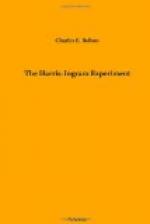The two artists visited Rotterdam, the second commercial city in Holland, which is fourteen miles from the North Sea and on the right bank of the Maas. An attractive quay a mile in length is the arriving and starting point for over 100 steamboats that connect Rotterdam with Dutch towns, the Rhine, England, France, Russia, and the Mediterranean.
Alfonso and Leo studied the collection of portraits at Boyman’s Museum, and sketched in the River Park the happy people who were grouped under trees, by the fish ponds, and along the grassy expanses. Alfonso bought a photograph of the illustrious Erasmus. It is about ten miles to Delft, once celebrated for its pottery and porcelain, a city to-day of 25,000 inhabitants. Here on the 10th of July, 1584, William of Orange, Founder of Dutch independence, was shot by an assassin to secure the price set on William’s head by Farnese.
Our two artists visited a church in Delft to see the marble monument to the memory of the Prince of Orange, which was inscribed “Prince William, the Father of the Fatherland.” Not far is Delft Haven which Americans love to visit, and where the pious John Robinson blessed a brave little band as it set sail to plant in a new world the tree of Liberty.
At length the artists reached The Hague, which for centuries has been the favorite residence of the Dutch princes, and to-day is occupied by the court, nobles, and diplomatists. No town in Holland possesses so many broad and handsome streets, lofty and substantial blocks, and spacious squares as The Hague.
Alfonso and Leo hastened to Scheveningen, three miles west of The Hague, on the breezy and sandy shores of the North Sea, a clean fishing village of neat brick houses sheltered from the sea by a lofty sand dune. Here bathing wagons are drawn by a strong horse into the ocean, where the bather can take his cool plunge. Scheveningen possesses a hundred fishing boats. The fishermen have an independent spirit and wear quaint dress. A public crier announces the arrival of their cargoes, which are sold at auction on the beach, often affording picturesque and amusing scenes, sketches of which were made. The luminous appearance of the sea caused by innumerable mollusca affords great pleasure to visitors, twenty thousand of whom every year frequent this fashionable sea-bathing resort.
The second evening after the artists’ arrival at Scheveningen, as they sauntered along on the brick-paved terrace in sight of white sails and setting sun, Alfonso was agreeably surprised to meet in company with her mother, Christine de Ruyter, a young artist, whose acquaintance he had made in the Louvre at Paris.
Christine’s father, prominent for a long time in the vessel trade, had recently died, leaving a fortune to his wife and two daughters, one of whom, Fredrika was already married. They were descended from the famous Admiral de Ruyter, who in 1673 defeated the united fleets of France and England off the coast of Scheveningen, which fact added much of interest to their annual visit to this resort. While Leo talked with the mother, Alfonso listened to Christine, as she told much about the historic family with which she was connected, and in return she learned somewhat of young Harris’s family and their visit to Europe.




